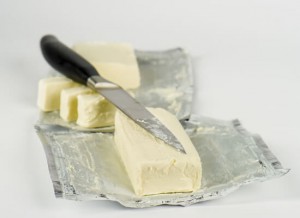You’ve likely noticed that in most recipe you’ve used, the ingredient list contains butter, margarine or spreads. But what’s different about these three seemingly similar ingredients?
Here’s the scoop on what makes butter, margarine and spreads unique. Each one has a different composition and can affect the quality, appearance and taste of whatever you’re making.
Overview
These are the basics of butter, margarine and spreads:
Butter
- Must contain at least 80 percent fat
- Contains less than 20 percent water
- Fat comes from milk fat
- Contains more saturated fat
- When it comes to flavor, butter offers the most taste for your palette. Margarine and shortening fall short on this characteristic

- Must contain at least 80 percent fat
- Contains less than 20 percent water
- Fat comes from vegetable and/or milk fat
- Some contain trans fat (more solid margarines contain more trans fat)
- Margarine is made from oil hardened by hydrogenation
Spreads
- Can contain less than 60 percent fat
- Contains up to 40 percent water
- Fat comes from vegetables
Tips for cooking and baking
Use what the recipe calls for, whether it’s butter, margarine or vegetable spread. Substituting a light butter for normal butter won’t yield the same results.
Higher fat content butters and margarines will result in more moist, tender, and more brown baked goods. If spreads that contain less fat and more water are used, expect baked goods to be more dry, tough and less brown.
Since margarine contains at least 80 percent fat, it will create better baked goods than using spreads that contain much less fat.
Nutrition
When possible, use a “spread” with zero grams trans-fat and the lowest amount of saturated fat. For baked goods, consider substituting pureed fruit for a quarter or third of the recipe’s fat.
When consuming butter, 1 or 2 teaspoons per day should be the limit because of the saturated fat content. The Cleveland Clinic shares this graphic about the nutritional value of butters and margarines to help you make heart healthy choices in your everyday eating.
Sources: Penn State University Extension, Land O’Lakes, U.S. National Library of Medicine
Get more Great Recipes in your inbox each week by getting
Around the Table.
It's a FREE weekly e-newsletter all about food. Sign Up Today!















